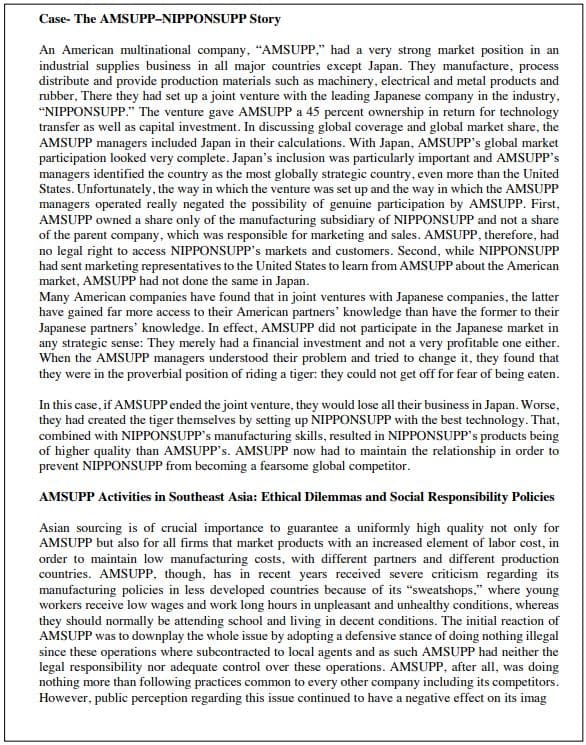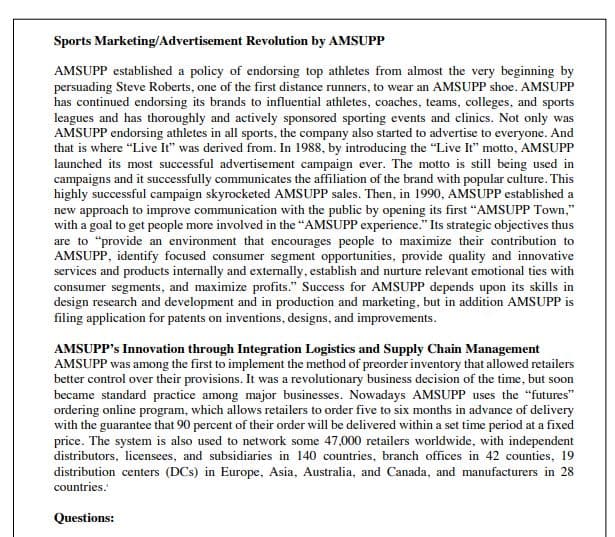(Question 5) Global Sourcing Strategy o Discussion on all aspects of the global sourcing strategy with clear details on the strategies that can be used when assessing all six (6) aspects if AMSUPP is to operate in Singapore as discussed in the course § Information for the case must be used to support the discussion The six aspects are of global sourcing strategy: Improve Supplier Relations Assess the current supply chain Develop sourcing strategy Identify and screen suppliers Contract suppliers Set up client local operations
(Question 5) Global Sourcing Strategy o Discussion on all aspects of the global sourcing strategy with clear details on the strategies that can be used when assessing all six (6) aspects if AMSUPP is to operate in Singapore as discussed in the course § Information for the case must be used to support the discussion The six aspects are of global sourcing strategy: Improve Supplier Relations Assess the current supply chain Develop sourcing strategy Identify and screen suppliers Contract suppliers Set up client local operations
Chapter1: Taking Risks And Making Profits Within The Dynamic Business Environment
Section: Chapter Questions
Problem 1CE
Related questions
Question
(Question 5)
Global Sourcing Strategy
o Discussion on all aspects of the global sourcing strategy with clear details on the strategies
that can be used when assessing all six (6) aspects if AMSUPP is to operate in Singapore
as discussed in the course
§ Information for the case must be used to support the discussion
The six aspects are of global sourcing strategy:
- Improve Supplier Relations
- Assess the current supply chain
- Develop sourcing strategy
- Identify and screen suppliers
- Contract suppliers
- Set up client local operations

Transcribed Image Text:Case- The AMSUPP-NIPPONSUPP Story
An American multinational company, "AMSUPP," had a very strong market position in an
industrial supplies business in all major countries except Japan. They manufacture, process
distribute and provide production materials such as machinery, electrical and metal products and
rubber, There they had set up a joint venture with the leading Japanese company in the industry,
"NIPPONSUPP." The venture gave AMSUPP a 45 percent ownership in return for technology
transfer as well as capital investment. In discussing global coverage and global market share, the
AMSUPP managers included Japan in their calculations. With Japan, AMSUPP's global market
participation looked very complete. Japan's inclusion was particularly important and AMSUPP's
managers identified the country as the most globally strategic country, even more than the United
States. Unfortunately, the way in which the venture was set up and the way in which the AMSUPP
managers operated really negated the possibility of genuine participation by AMSUPP. First,
AMSUPP owned a share only of the manufacturing subsidiary of NIPPONSUPP and not a share
of the parent company, which was responsible for marketing and sales. AMSUPP, therefore, had
no legal right to access NIPPONSUPP's markets and customers. Second, while NIPPONSUPP
had sent marketing representatives to the United States to learn from AMSUPP about the American
market, AMSUPP had not done the same in Japan.
Many American companies have found that in joint ventures with Japanese companies, the latter
have gained far more access to their American partners' knowledge than have the former to their
Japanese partners' knowledge. In effect, AMSUPP did not participate in the Japanese market in
any strategic sense: They merely had a financial investment and not a very profitable one either.
When the AMSUPP managers understood their problem and tried to change it, they found that
they were in the proverbial position of riding a tiger: they could not get off for fear of being eaten.
In this case, if AMSUPP ended the joint venture, they would lose all their business in Japan. Worse,
they had created the tiger themselves by setting up NIPPONSUPP with the best technology. That,
combined with NIPPONSUPP's manufacturing skills, resulted in NIPPONSUPP's products being
of higher quality than AMSUPP's. AMSUPP now had to maintain the relationship in order to
prevent NIPPONSUPP from becoming a fearsome global competitor.
AMSUPP Activities in Southeast Asia: Ethical Dilemmas and Social Responsibility Policies
Asian sourcing is of crucial importance to guarantee a uniformly high quality not only for
AMSUPP but also for all firms that market products with an increased element of labor cost, in
order to maintain low manufacturing costs, with different partners and different production
countries. AMSUPP, though, has in recent years received severe criticism regarding its
manufacturing policies in less developed countries because of its "sweatshops," where young
workers receive low wages and work long hours in unpleasant and unhealthy conditions, whereas
they should normally be attending school and living in decent conditions. The initial reaction of
AMSUPP was to downplay the whole issue by adopting a defensive stance of doing nothing illegal
since these operations where subcontracted to local agents and as such AMSUPP had neither the
legal responsibility nor adequate control over these operations. AMSUPP, after all, was doing
nothing more than following practices common to every other company including its competitors.
However, public perception regarding this issue continued to have a negative effect on its imag

Transcribed Image Text:Sports Marketing/Advertisement Revolution by AMSUPP
AMSUPP established a policy of endorsing top athletes from almost the very beginning by
persuading Steve Roberts, one of the first distance runners, to wear an AMSUPP shoe. AMSUPP
has continued endorsing its brands to influential athletes, coaches, teams, colleges, and sports
leagues and has thoroughly and actively sponsored sporting events and clinics. Not only was
AMSUPP endorsing athletes in all sports, the company also started to advertise to everyone. And
that is where "Live It" was derived from. In 1988, by introducing the "Live It" motto, AMSUPP
launched its most successful advertisement campaign ever. The motto is still being used in
campaigns and it successfully communicates the affiliation of the brand with popular culture. This
highly successful campaign skyrocketed AMSUPP sales. Then, in 1990, AMSUPP established a
new approach to improve communication with the public by opening its first "AMSUPP Town,"
with a goal to get people more involved in the "AMSUPP experience." Its strategic objectives thus
are to "provide an environment that encourages people to maximize their contribution to
AMSUPP, identify focused consumer segment opportunities, provide quality and innovative
services and products internally and externally, establish and nurture relevant emotional ties with
consumer segments, and maximize profits." Success for AMSUPP depends upon its skills in
design research and development and in production and marketing, but in addition AMSUPP is
filing application for patents on inventions, designs, and improvements.
AMSUPP's Innovation through Integration Logistics and Supply Chain Management
AMSUPP was among the first to implement the method of preorder inventory that allowed retailers
better control over their provisions. It was a revolutionary business decision of the time, but soon
became standard practice among major businesses. Nowadays AMSUPP uses the "futures"
ordering online program, which allows retailers to order five to six months in advance of delivery
with the guarantee that 90 percent of their order will be delivered within a set time period at a fixed
price. The system is also used to network some 47,000 retailers worldwide, with independent
distributors, licensees, and subsidiaries in 140 countries, branch offices in 42 counties, 19
distribution centers (DCs) in Europe, Asia, Australia, and Canada, and manufacturers in 28
countries.
Questions:
Expert Solution
This question has been solved!
Explore an expertly crafted, step-by-step solution for a thorough understanding of key concepts.
Step by step
Solved in 3 steps

Recommended textbooks for you

Understanding Business
Management
ISBN:
9781259929434
Author:
William Nickels
Publisher:
McGraw-Hill Education

Management (14th Edition)
Management
ISBN:
9780134527604
Author:
Stephen P. Robbins, Mary A. Coulter
Publisher:
PEARSON

Spreadsheet Modeling & Decision Analysis: A Pract…
Management
ISBN:
9781305947412
Author:
Cliff Ragsdale
Publisher:
Cengage Learning

Understanding Business
Management
ISBN:
9781259929434
Author:
William Nickels
Publisher:
McGraw-Hill Education

Management (14th Edition)
Management
ISBN:
9780134527604
Author:
Stephen P. Robbins, Mary A. Coulter
Publisher:
PEARSON

Spreadsheet Modeling & Decision Analysis: A Pract…
Management
ISBN:
9781305947412
Author:
Cliff Ragsdale
Publisher:
Cengage Learning

Management Information Systems: Managing The Digi…
Management
ISBN:
9780135191798
Author:
Kenneth C. Laudon, Jane P. Laudon
Publisher:
PEARSON

Business Essentials (12th Edition) (What's New in…
Management
ISBN:
9780134728391
Author:
Ronald J. Ebert, Ricky W. Griffin
Publisher:
PEARSON

Fundamentals of Management (10th Edition)
Management
ISBN:
9780134237473
Author:
Stephen P. Robbins, Mary A. Coulter, David A. De Cenzo
Publisher:
PEARSON